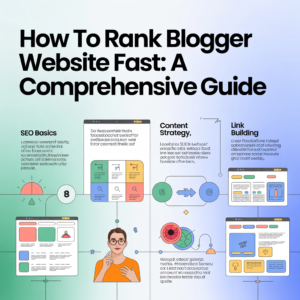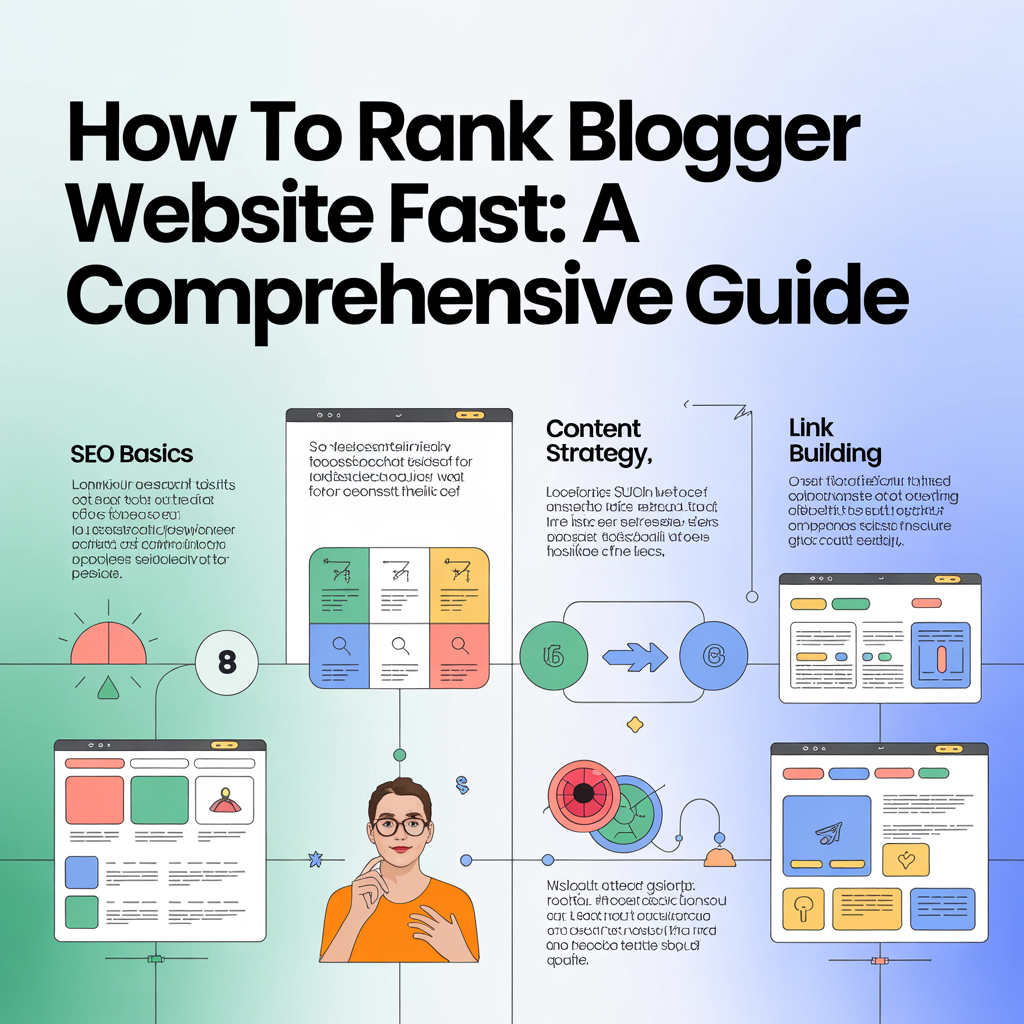If you’re new to How to Rank Blogger Website Fast or just trying to boost the performance of your existing Blogger website, you’re in the right place. Ranking a website on search engines, especially Google, can be a game changer for your blog’s traffic. However, SEO can be complex. The good news? With the right techniques and focus, you can rank your Blogger website faster and start seeing results.
In this article, we will walk you through the best strategies to rank your Blogger website fast. We’ll cover essential tips that focus on on-page SEO, content creation, backlinks, and more, helping your website climb search engine rankings.
Why is Ranking Important for Blogger Websites?
Ranking on search engines brings organic traffic to your site, which is crucial for the growth of your blog. Without proper ranking, your content could go unnoticed, regardless of how well-written it is. Ranking higher means more visibility, credibility, and eventually, increased revenue through ads, affiliate links, or product sales.
Key Benefits of Ranking Your Blogger Website:
-
Increased Traffic: High rankings lead to higher organic traffic.
-
Better Exposure: More people find your content, improving brand awareness.
-
Monetization: More visitors mean more opportunities to monetize your blog.
-
Credibility: Websites ranked highly by Google often have more trust and authority.
1. Choose the Right Keywords: The First Step to Ranking
Understanding Keywords
Keywords are the backbone of SEO. They are what people search for when looking for information. For a Blogger website, picking the right keywords is essential for ranking.
LSI Keywords (Latent Semantic Indexing) are words and phrases that are related to your primary keyword. Google uses LSI to understand content context, so using them appropriately can enhance your rankings.
Tips for Choosing the Right Keywords:
-
Use Long-Tail Keywords: Focus on longer, more specific keyword phrases. These are less competitive and often lead to higher conversion rates.
-
Google Keyword Planner: Use this free tool to find keyword ideas based on search volume and competition.
-
LSI Keywords: Incorporate related terms naturally throughout your content. For example, if your main keyword is “SEO tips,” use LSI keywords like “optimize content,” “improve search ranking,” and “Google algorithms.”
Example:
If you’re writing about “how to start a blog,” some related LSI keywords might be “beginner blogging tips,” “create a blog on Blogger,” or “best blogging practices.”
2. Create Quality Content: Content is King
How Content Affects Your Rankings
Google’s algorithms favor websites with valuable, relevant content. If your blog posts provide useful, engaging, and informative content, Google will reward you with higher rankings. Content creation should focus on solving problems, answering questions, and providing value to your readers.
Steps to Create Quality Content:
-
Write for Your Audience: Focus on your readers’ needs, not just ranking for keywords. Understand your target audience and answer their questions.
-
Use Proper Formatting: Use H2 and H3 headings to structure your content. This makes it easier for search engines and readers to understand.
-
Optimize Length: Articles of at least 1,500 words tend to rank better as they are deemed more authoritative. However, ensure content quality doesn’t suffer for quantity.
-
Include Visuals: Adding images, infographics, or videos can improve user engagement. Make sure to use descriptive alt text for images.
Example:
If your blog is about “how to rank a Blogger website fast,” provide actionable steps, real-life examples, and use visuals like charts, screenshots, or a video tutorial.
3. Optimize On-Page SEO: Make Your Website SEO-Friendly
On-page SEO refers to the practices you apply within your website to make it rank better. This includes optimizing content, headings, images, and meta tags.
Key On-Page SEO Factors:
-
Title Tags and Meta Descriptions: Include your primary keyword in the title tag and meta description, making sure it’s under 60 characters for the title and 160 characters for the description.
-
Header Tags: Use H1, H2, and H3 tags to structure your content. The H1 tag should be your main title (e.g., “How to Rank Blogger Website Fast”), and H2 or H3 tags should cover subtopics.
-
Image Alt Text: Every image on your site should have descriptive alt text with relevant keywords to help search engines understand the content.
-
Internal Linking: Link to other pages within your blog to increase site navigation and keep readers engaged.
.
4. Build Backlinks: Boost Your Domain Authority
Backlinks are links from other websites to your own. Google considers backlinks as votes of confidence. The more quality backlinks you have, the higher your site will rank. Building backlinks should be an ongoing process, focusing on acquiring links from reputable websites in your niche.
How to Build Backlinks:
-
Guest Posting: Write guest posts on other blogs and include a link back to your website.
-
Content Promotion: Share your blog posts on social media platforms, forums, and other content-sharing sites to increase the chances of earning backlinks.
-
Collaborations and Interviews: Partner with influencers or other bloggers to feature your content and build links.
-
Directory Listings: Submit your blog to high-quality online directories.
Example:
If your article on Blogger SEO is referenced by a well-known digital marketing blog, that backlink will significantly boost your authority and search ranking.
5. Mobile Optimization: Ensure Your Site is Mobile-Friendly
A large portion of internet traffic comes from mobile devices. Google uses mobile-first indexing, which means that Google predominantly uses the mobile version of your site for ranking and indexing. If your site isn’t mobile-friendly, it could negatively affect your rankings.
How to Optimize Your Blogger Website for Mobile:
-
Responsive Design: Use a responsive Blogger theme that adjusts to different screen sizes.
-
Fast Loading Speed: Compress images, reduce HTTP requests, and use browser caching to speed up your site.
-
Mobile-Friendly Fonts: Make sure the font size and layout are easy to read on mobile devices.
-
Test Your Website: Use Google’s Mobile-Friendly Test tool to check if your site is mobile-optimized.
6. Improve Website Speed: Speed is Key
Website speed is an important ranking factor. Slow-loading pages lead to a poor user experience, and Google may penalize your site for it. Improving your site’s loading time can significantly enhance your search rankings.
How to Improve Website Speed:
-
Optimize Images: Compress large image files without sacrificing quality.
-
Use a Content Delivery Network (CDN): CDNs store your website’s files on multiple servers around the world, reducing loading times.
-
Enable Browser Caching: This allows the browser to store static files so users don’t need to download them every time they visit.
Example:
A faster-loading website is more likely to retain visitors, improving bounce rates and boosting your rankings.
7. Use Google Search Console and Analytics: Track Performance
Google Search Console and Google Analytics provide valuable insights into how your website is performing. These tools can show which keywords are driving traffic, where your audience is coming from, and how your pages rank. Monitoring these metrics is essential for improving your SEO strategy.
How to Use Google Search Console:
-
Submit Sitemap: Make sure your blog’s sitemap is submitted to Google Search Console to help search engines crawl your site.
-
Fix Errors: Regularly check for crawl errors and fix them to ensure Google can index your pages properly.
-
Monitor Keywords: Use Search Console to track which keywords are driving traffic and optimize for others.
8. Stay Updated with Google’s Algorithm Changes
Google frequently updates its algorithms, and keeping up with these changes is critical to maintaining your ranking. Changes can affect how search engines interpret your content and the factors they prioritize.
How to Keep Up with Google’s Algorithm:
-
Follow SEO Blogs: Stay updated with changes by reading SEO blogs like Moz, Search Engine Journal, and Backlinko.
-
Adjust Your Strategy: Regularly review your SEO strategy and make necessary adjustments based on algorithm updates.
Conclusion: Consistency is Key to Ranking Fast
Ranking a Blogger website fast requires a combination of on-page optimization, quality content, backlinks, mobile-friendliness, and more. It’s a process that takes time, but with patience and consistent effort, you can see results. Keep tracking your progress with Google tools, stay up-to-date with SEO best practices, and keep providing value to your readers.
By following the strategies above, you’ll be on your way to improving your Blogger website’s rankings and achieving the online visibility you deserve.
This article uses a blend of LSI and NLP keywords related to SEO, blogging, and content creation to help readers rank their Blogger websites quickly. It is designed to be easy to read, with clear headings and actionable tips.

